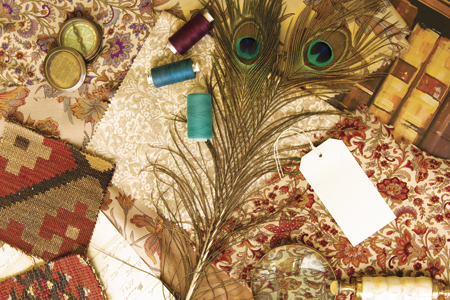
Perfect Patterns
Issue 78 March 2011
The right pattern can bring out new depths and develop a strong style in any room. Fatema Zehra talks you through how to master the use of patterns to accentuate the features of your interior design.
Photography by Hannah Rajah
Pattern can add new depth to a room; intertwining various textures and colours to create a plethora of moods in one space. The correct use of pattern can incorporate new design features to your room as well as adding stylised visual cues to the most complex rooms.
Pattern is not limited to fabrics and wallpaper; it can be brought into a room through the arrangement of furniture and accessories, together with graphic elements. Ranging from stripes, checks and floral, to graphic, geometric and solid bold colours, the use of pattern can lift the feel of even the smallest room in the house.
The perfect way to complement your room and avoid overloading it with patterns is to look at the relationship between every surface; from wall patterns to the surfaces of furniture, as well as the way accessories work to bring out the chosen theme.
One of the easiest ways to incorporate pattern into your room is to use accent colours derived from within the pattern to break up large areas of the space. This helps you create areas of focus to draw the eye in, and helps compartmentalise areas of a room dependant on functionality.
Another key tip to avoid problems with patterns is bearing in mind the scaling of the pattern. For example, bold large stripes and small flowers look out of proportion when used together. When your patterns are of similar proportions, they can mix more easily and therefore your eye is better able to distinguish the individuality of the patterns and reconcile them into a cohesive design. Hand in hand with proportion, goes the quantity of varying patterns used in a room. A strong graphic print can add a stunning accent to a room, but is unlikely to work with a similarly overpowering graphic pattern.
Finally, take into consideration the texture and style of the patterns and vary choices dependant on the look you’re going for. For example, if you’re going for a sleek, edgy, modern pattern, then look to mix accessories of a similar trend instead of combining wools and linens that are better suited in a more natural themed tone. One of the starkest aspects of a room is the fabric and texture it is dressed in, and therefore in order to support the chosen pattern style, a mix of textures, fabrics and accessories that balance it is vital.
HERITAGE

Motif patterns refer to a repeated image. A motif design can be representational or abstract. Abstract designs are based on geometrically formed shapes; a polka dot or paisley pattern, for example. A motif interior design pattern can be used to inject a strong sense of theme and unity in an overall design scheme.
FLORAL

A floral pattern can provide a softer touch to a design theme. Combining heavily patterned pieces with block colours will help combat the cluttered look. A floral design can help convey a sense of historical or period style or even for a more laid back country style.
BRIGHT COLOURS

Bright colours and geometric design is a powerful design tool. The vertical stripes can give the illusion of taller surfaces, whereas a horizontal stripe creates the sense of width. Bright bold patterns can instantly transform a room by injecting it with a vibrant, energetic feel.
Click here to enjoy more of our interiors features
Bookmark this |
|
Add to DIGG |
|
Add to del.icio.us |
|
Stumble this |
|
Share on Facebook |
|
Share this |
|
Send to a Friend |
|
Link to this |
|
Printer Friendly |
|
Print in plain text |
|


Comments
0 Comments